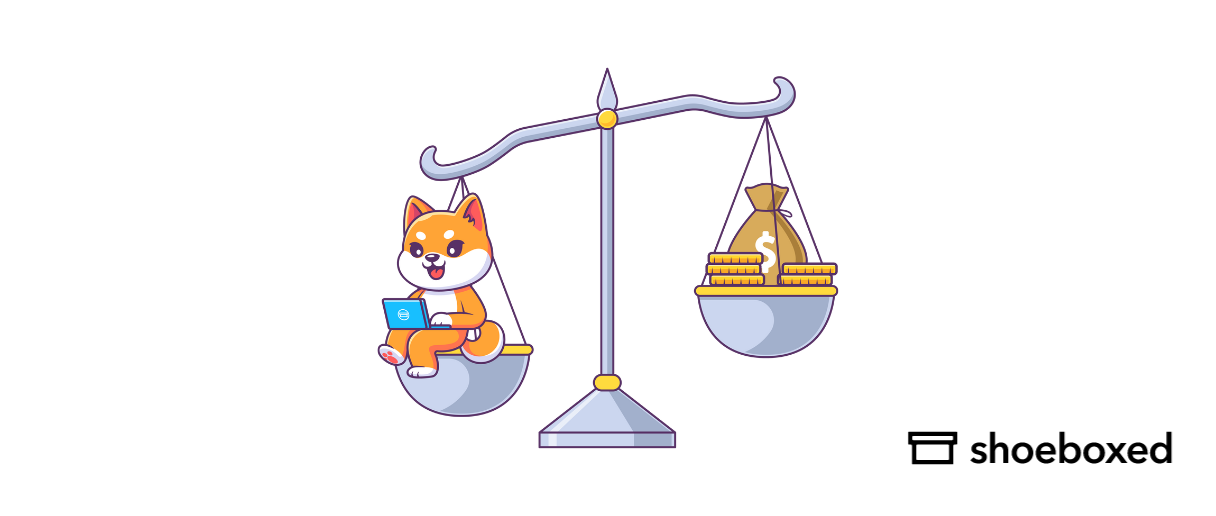As a graphic designer, managing finances and ensuring accurate billing and invoicing can be just as crucial as delivering eye-catching designs to clients.
To stay organized and maintain a steady cash flow, it’s important to find accounting software for graphic designers that cater to their unique needs.
From tracking expenses and invoicing clients to sales taxes and generating in-depth financial reports, these software programs help graphic designers stay in control of their finances and focus their time and energy on creating stunning designs.
In this guide, we’ll explore the best accounting software for graphic designers to help you make an informed decision for your business needs!
What are the accounting software essentials for graphic designers?
Accounting software essentials specifically cater to the needs of graphic designers.
1. Invoicing and expenses
An essential feature of any accounting software for graphic designers is a robust invoicing and expense management system.
This enables designers to easily create professional invoices, track expenses, and manage their cash flow.
For example, FreshBooks is a popular accounting solution with complex billing needs, providing a range of invoice templates and customization options.
2. Payments and billing
Efficient payments and billing processing are crucial for graphic designers to receive timely compensation for their services.
Solutions like Bonsai and QuickBooks can handle various payment methods and currencies, ensuring seamless transactions.
This includes integrations with popular payment gateways and recurring billing or installment plan options.
3. Income and financial reports
Keeping track of income and generating accurate financial reports are crucial for graphic designers to make informed business decisions.
Many accounting software options, such as ZipBooks, provide easy access to crucial financial metrics, including profit and loss statements and balance sheets.
This helps designers understand their business’s financial health and identify areas for growth.
Turn receipts into data for tax time ✨
Try Shoeboxed’s systematic award-winning approach to receipt tracking for tax season. Try free for 30 days!
Get Started Today4. Automation and streamlining
Automating tedious manual tasks can save graphic designers time and prevent errors in their accounting processes.
The best accounting software for graphic designers offers features such as automatic time tracking and syncing across devices, allowing designers to focus on their core creative work.
Other features like bank transaction imports and automated expense categorization can also streamline day-to-day accounting tasks.
5. Managing taxes and payroll
For graphic designers who employ staff or need to manage their taxes, accounting software with tax and payroll features is essential.
Software that provides tax estimations and can help with filing make it easier to stay compliant with various tax jurisdictions.
Additionally, payroll integrations ensure that employees are paid accurately and on time.
6. Integrations and mobility
Graphic designers often work on projects in various locations and need access to their accounting software on the go.
Many solutions offer mobile apps, allowing designers to track business expenses, send invoices, and manage their business finances from anywhere.
Furthermore, integrations with other business tools like project management software and customer relationship management (CRM) systems can improve organization and efficiency.
What is the best accounting software for graphic designers in 2024?
Here are some of the most highly recommended accounting software for graphic designers in 2024.
1. FreshBooks

FreshBooks homepage
FreshBooks is ideal for graphic designers with complex billing needs.
This software offers online and automatic payment solutions to ensure a faster payment process, recurring invoices for repeat clients, late payment reminders, and late payment fees.
FreshBooks’ key features include invoicing, a time-tracking feature, and expense management.
Pros:
User-friendly interface for those graphic designers with little accounting knowledge.
Customizable invoices such as recurring invoices for repeat clients.
Automated reminders and payment tracking.
Cons:
Limited advanced features.
Additional costs for adding team members.
Pricing: Starts at $15/month.
2. Shoeboxed
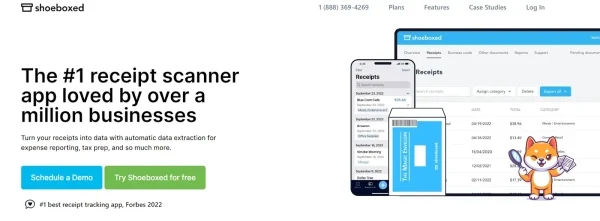
Shoeboxed digitizes your paper receipts and business documents so you can access them wherever you are.
Shoeboxed is a receipt scanning and document management software that’s useful for designers looking to keep track of their expenses without manual data entry in a receipt book or spreadsheet.
How can Shoeboxed help graphic designers?
With Shoeboxed, graphic designers can organize and digitize receipts, making it easier to track and report expenses during tax time.
Shoeboxed’s mobile app lets you snap receipts on the go for lunches and dinners with clients or for those last-minute supplies you had to purchase.
Each receipt you send to processing will have its data human-verified before it’s uploaded to your account and automatically categorized into 15 editable tax categories, including:
Meals
Fuel
Office Supplies
Advertising
Postage/Shipping
And more!
If those categories don’t quite cut it, you can create your own categories and edit the receipt details for more accurate expense tracking tailored to graphic design.
Shoeboxed also has a built-in mileage tracker that you can use while traveling for business to deduct from your taxes or accurately bill clients.
Any miles spent on the road for work will automatically be added to your account and included on expense reports.
How does Shoeboxed work with accounting software?
Shoeboxed’s integration with accounting software like Wave, QuickBooks, and Xero simplifies and streamlines the accounting process for graphic designers.
The most popular integration for Shoeboxed users is QuickBooks for easy expense organization and tax preparation.
Though the integration with QuickBooks isn’t automatic, it’s still pretty seamless and gives you control over what expenses go to your QuickBooks account.
To use the integration, you would need to manually select the receipts you want to transfer over to QuickBooks.
Shoeboxed does the rest by categorizing and neatly organizing your expense details inside QuickBooks!
How can Shoeboxed’s Magic Envelope help graphic designers?

Shoeboxed’s Magic Envelope is a mail-in receipt scanning service for businesses.
Unlike other receipt-scanning and accounting software, the Magic Envelope service is unique to Shoeboxed and allows graphic designers to outsource their receipt scanning.
When you choose a plan that includes the Magic Envelope, Shoeboxed will send you a post-pre-paid envelope for you to mail your receipts (and other documents, like client invoices or your design portfolio).
To get started, you would simply stuff your receipts and other papers into the envelope, mail it free of charge, and once it arrives at Shoeboxed’s scanning facility, your documents will be data verified and scanned into your account.
This is a fantastic option if you have mounds of old paper receipts lying around, more client invoices than you know what to do with, or graphic design documents that showcase your work.
Shoeboxed makes it easy to access your receipts, your portfolio, invoices, or anything else you might want to have a digital copy of.
Pros:
Streamlined expense tracking for meals with clients, office supplies, travel expenses, advertising costs, and professional development expenses.
Mobile app to snap receipts for meals with clients and travel expenses.
Magic Envelope service outsources receipt and document scanning.
Create expense reports for tax time or in the event of an audit.
Cons:
Limited functionality compared to full accounting software.
Pricing: From $18/month.
Shoeboxed Demo by Shoeboxed YouTube
Break free from manual data entry ✨
Use Shoeboxed’s Magic Envelope to ship off your receipts and get them back as scanned data in a private, secure cloud-based account. 📁 Try free for 30 days!
Get Started Today3. QuickBooks
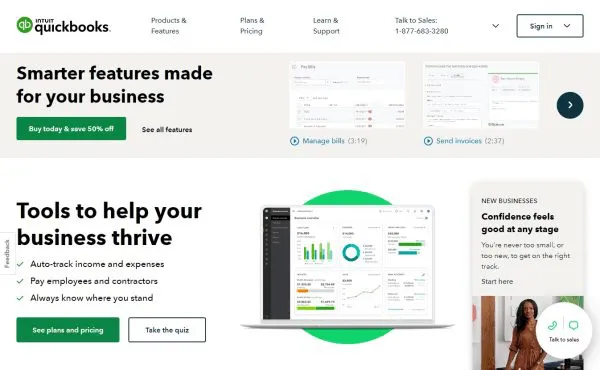
QuickBooks Online.
QuickBooks is a popular choice for graphic designers who want to manage and streamline their business finances.
This comprehensive accounting software provides invoicing with automated follow-up reminders to clients, expense tracking, and inventory management features.
Their thorough business reporting allows graphic designers to stay on top of their finances, ensuring a proactive approach to the growth and success of their business.
Pros:
Comprehensive feature set for graphic designers such as invoicing clients, thorough business reporting, organizational tools, financial transparency, and a client and contractor hub.
Third-party integrations are available.
Cons:
Steeper learning curve for beginners.
Pricing: Starts at $25/month.
4. Zoho Books
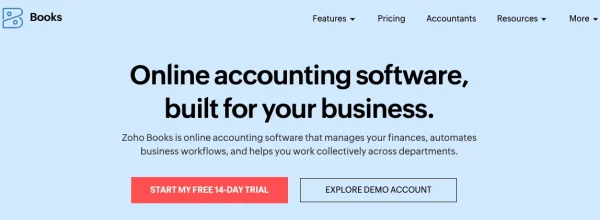
Zoho Books accounting software.
Zoho Books offers an easy-to-use accounting solution with customizable reports, seamless time tracking, and free invoicing for graphic designers.
This software also features payment reminders, various payment options, and a mobile app for designers on the go.
Zoho integrates with other services from the Zoho Suite for added flexibility.
Pros:
Intuitive interface for graphic designers with little to no accounting experience.
Customizable reports for financial analytics.
Cons:
Limited third-party integrations.
Pricing: Starts at $9/month.
5. Neat

Neat for organizing expenses.
Neat provides document organization and invoice management, targeting small business owners and freelancers such as graphic designers.
This software provides real-time access to sales, spending, expenses, and income taxes for easy reporting and filing for graphic design businesses.
Neat is focused on simplifying bookkeeping tasks and can be integrated with other accounting software tools.
Pros:
User-friendly design for easy and intuitive navigation.
Supports multiple file formats.
Cons:
Additional cost for advanced features such as automated insights.
Pricing: Starts at $23/month. Checkout our Neat receipt alternative article for you like neat but want something different.
6. Bonsai

Bonsai for project management and expense tracking.
Bonsai is specifically designed for freelancers and graphic designers with high workloads. It offers project management, invoicing, and time tracking, among other features.
This software is a great tool for graphic designers because they can run their entire business in one place with client CRM, project management, invoicing, and financial features.
Some of Bonsai’s features for graphic designers include billing, time-tracking, proposals, contracts, specialized forms, business reporting, and a client portal.
Pros:
Designed for creatives who want an all-in-one solution.
End-to-end project management from managing leads to payments for your designs.
Cons:
Limited scalability for larger teams.
Pricing: From $19/month.
7. ZipBooks

ZipBooks homepage.
ZipBooks is perfect for graphic designers with no accounting experience, offering a straightforward interface with vital accounting features such as invoicing, expense management, and built-in reporting.
This software offers a free invoice template specially created for graphic design businesses, automated expense tracking, and a full suite of reports to give you insight and keep your business on track.
Pros:
Easy to use for graphic designers with no accounting experience.
Built-in reporting tools for insight into your graphic design business.
Free graphic design invoice template.
Cons:
Limited advanced features.
Pricing: Free version available; paid plans from $15/month.
8. Sage Business Cloud Accounting
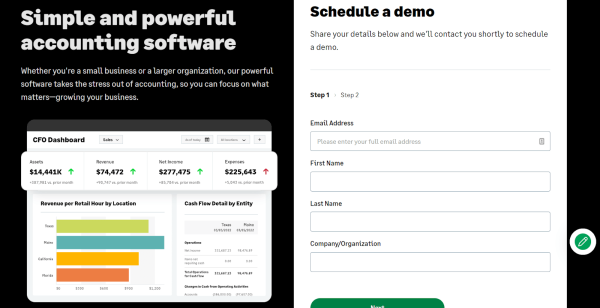
Sage homepage.
Sage Business Cloud Accounting is a comprehensive solution for small businesses with a range of features, including invoicing, payment processing, and expense management.
This software also features inventory management and an electronic invoice payment system.
Sage is a great option for graphic designers seeking a scalable platform.
Pros:
Cloud-based system for graphic designers on the go.
Customizable and large range of reports.
Great for scaling as your business grows.
Cons:
Limited third-party integrations.
Pricing: From $10/month.
9. Xero
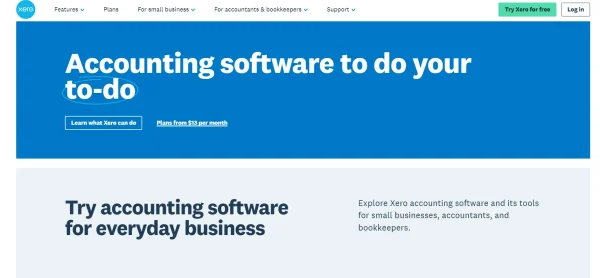
Xero accounting software.
Xero offers extensive features and integrations, catering to graphic designers looking for a robust accounting platform.
Some key features include invoicing, expense tracking, inventory management, project tracking, bill payment, bank connections, client and contact management, generating purchase orders, multi-currency options, and fixed asset management.
Pros:
Comprehensive feature set for graphic designers such as invoicing, expense tracking, and inventory management.
Wide range of third-party integrations.
Cons:
Steeper learning curve.
Pricing: Starts at $12/month.
10. Wave

Wave accounting software for businesses.
Wave is a free accounting software for small businesses and freelancers, with key features such as invoicing, payment processing, and expense management.
There is a fee for graphic designers looking for advanced features such as payroll and bookkeeping training, but Wave’s user-friendly interface makes it an ideal choice for those with no accounting experience.
Pros:
Free to use.
Easy-to-use interface for graphic designers with no accounting experience.
Cons:
Limited advanced features with just payroll and bookkeeping coaching.
Ads in the free version.
Pricing: Free, with optional paid services available such as payroll and access to expert advisors.
Best accounting software for designers by Jeremy MuraWhat are other key features to look for in accounting software for graphic designers?
There are essentials and then there are other generalized features that simplify the accounting process for graphic designers.
Below are some other features to consider when choosing the right software for you.
1. Ease of use
The ideal accounting software should be user-friendly, allowing graphic designers to manage their finances with confidence and precision.
An intuitive interface with clear navigation and easy access to key features is crucial and ensures that you can focus more on your design projects rather than struggle with complicated accounting tools.
2. Time tracking
Efficient time-tracking abilities are essential for accurately logging billable hours and managing project deadlines.
Look for software that offers integrated time-tracking features that can be directly linked to your billing and project management systems, simplifying the entire bookkeeping process.
3. Expense tracking
Keeping track of project expenses is important to ensure accurate cost allocation and budget management.
Ideally, accounting software designed for graphic designers should have robust expense-tracking capabilities.
Shoeboxed is a great option for this and allows you to categorize meal expenses, travel expenses, and the expense of graphic design tools and supplies for expense reports and tax deductions.
4. Mileage tracking
For those who travel frequently for work or meetings, mileage tracking can be useful for reimbursing the expenses incurred and calculating tax deductions. Shoeboxed offers a built-in mileage tracking system that makes tracking mileage a breeze.

Track business miles with Shoeboxed.
Not all accounting software may include this feature, so consider your specific needs when selecting the best software for your business.
5. Bank reconciliation
Bank reconciliation features help you efficiently manage your income and expenses by comparing your transaction records to your bank’s records.
This facilitates accurate financial reporting and helps detect discrepancies or errors, ensuring the integrity of your financial data.
Shoeboxed’s expense reports can be a helpful tool when trying to reconcile your accounts. With Shoeboxed, you can create PDF or CSV file reports with receipts attached to have all of your expenses in a nice and neat list.

Example of a Shoeboxed CSV expense report.
If certain expenses are out of wack (like expenses on supplies, for example), you can even create a report just for the receipts related to the discrepancy.
6. Inventory management
While inventory management might not be a primary concern for all graphic designers, it could be beneficial for those selling design-related products, like prints or merchandise.
Look for software that offers inventory-tracking features to maintain accurate stock levels and manage product sales.
7. Payment processing
Efficient payment processing is vital to ensure timely and accurate invoicing and streamlined cash flow management.
Choose accounting software that supports a variety of payment methods, like credit cards and online payments, and can integrate with your existing payment gateways for maximum convenience.
8. Workflow automation
Workflow automation features can simplify repetitive tasks, like generating and sending invoices out, tracking time, and sending payment reminders.
This saves you valuable time and helps maintain consistency in your financial processes.
Select software that offers customizable workflow and business process automation to suit your specific needs.
How can you optimize accounting software for your graphic design business?
Optimizing accounting software for a graphic design business frees up time for designers to spend on higher-value tasks such as growing their business.
1. Customization and collaboration
For a graphic design business, it’s essential to choose accounting software that offers a high degree of customization.
This allows you to adapt the software to your specific needs and preferences and helps streamline your workflow.
Additionally, consider software that enables collaboration among your team members, particularly if you work with other designers or have staff assisting with administrative tasks.
How can Shoeboxed help with designer collaboration?
Shoeboxed is a great way to keep tabs on fellow designers and their expenses.
If you’re a designer that has employees, or you work with other designers on various projects, Shoeboxed allows admins to add an unlimited number of (free!) sub-users to their accounts to scan business-related receipts and documents.
Graphic designers can also add their accountants to their Shoeboxed accounts to view their finances.
NOTE: While free sub-users are great, just keep in mind that everyone added to the account will be able to see others’ receipts and documents.
2. Branding and document management
Since 80% of small businesses say that the design of their marketing/branding tools is crucial to their business, having the ability to incorporate your branding onto invoices, quotes, and other financial documents is an added bonus and gives a professional touch for your clients.
Accounting software that supports this feature can make a difference in how your business is perceived.
Efficient document management is also needed to keep essential records organized and easily accessible—a feature worth considering when selecting the best accounting software used for your graphic design business.
How can Shoeboxed help manage documents?
Shoeboxed can also be used as document management system, and it allows you to digitize all types of documents for businesses and organize them*.
*Shoeboxed cannot scan and process documents wider than a regular sheet of paper or longer than 3 feet.
3. Financial statements
Preparing accurate financial statements is crucial to understanding your business performance and making informed decisions.
A good accounting software solution should generate comprehensive financial statements, such as balance sheets, profit and loss statements, expense reports, and cash flow statements.
By doing so, you’ll have a clear understanding of your financial health and can take appropriate actions to maintain or improve it.
How can Shoeboxed help with financial statements?
With Shoeboxed‘s expense reporting, users can download a CSV or PDF to view all of their expenses in a cohesive list. All expenses have photos of the receipts attached for viewing.
This is great for getting a birds-eye view of business expenses or for tax season.
4. Industry-specific tools and integrations
When selecting accounting software for your graphic design business, consider if it includes industry-specific tools or integrates with industry-standard programs such as Adobe Illustrator and Adobe InDesign.
This can help streamline your processes and improve your overall efficiency.
An ideal accounting software for a graphic design business should be customizable, support collaboration, include branding and document management features, generate financial statements, and offer industry-specific tools and integrations.
By optimizing these aspects, you can focus more on doing what you love—designing—while ensuring your business runs smoothly.
Frequently asked questions
What are the top accounting software options for freelancers in creative industries?
There are several accounting software options tailored for freelancers in creative industries, including graphic designers. Some of the top choices are FreshBooks, Bonsai, and QuickBooks.
Which accounting software is the most user-friendly for graphic designers?
FreshBooks is considered to be one of the most user-friendly accounting software options for freelance graphic designers. Its intuitive design, simple navigation, and customizable invoicing make it an excellent choice for managing finances.
How does Wave Financial compare to FreshBooks and Xero for creatives?
While all three options offer solid accounting features, Wave Financial is a free platform, making it more appealing to budget-conscious creatives. However, both FreshBooks and Xero offer more advanced features and integrations that can be beneficial for growing businesses.
Are there any free accounting software solutions suitable for graphic designers?
Yes, Wave Financial is a prominent free accounting software solution suitable for graphic designers. It provides basic invoicing, expense tracking, and financial reporting to help manage business finances effectively.
Which accounting software is best for tracking expenses in the graphic design field?
Shoeboxed is praised for its receipt scanning capabilities, making it an excellent option for graphic designers who need to track expenses efficiently. Shoeboxed allows users to capture receipts using the mobile app or mail receipts in the Magic Envelope, which are then sorted and categorized for easier expense management.
How can Zoho Corporation and FreeAgent help graphic designers manage their finances?
Both Zoho Books and FreeAgent offer intuitive and powerful accounting tools designed to simplify financial management for graphic designers. They provide features such as invoicing, expense tracking, late payment reminders, time tracking, and reporting, helping freelancers stay organized and maintain a clear financial overview.
Conclusion
Choosing the right accounting software is essential for graphic designers looking to simplify their financial management and focus on their creative work.
FreshBooks stands out with its invoicing, time tracking, expenses, and reporting capabilities.
Bonsai caters to designers with a high workload, while Shoeboxed offers convenient receipt scanning features and expense categorization for expense reports and tax deductions.
For those with little or no accounting experience, ZipBooks proves to be a user-friendly option.
By investing in the optimal accounting software for graphic designers, financial tasks can be streamlined, allowing more time to spend on their passion for design.
Caryl Ramsey has years of experience assisting in different aspects of bookkeeping, taxes, and customer service. She uses a variety of accounting software for setting up client information, reconciling accounts, coding expenses, running financial reports, and preparing tax returns. She is also experienced in setting up corporations with the State Corporation Commission and the IRS.
About Shoeboxed!
Shoeboxed is a receipt scanning service with receipt management software that supports multiple methods for receipt capture: send, scan, upload, forward, and more!
You can stuff your receipts into one of our Magic Envelopes (prepaid postage within the US). Use our receipt tracker + receipt scanner app (iPhone, iPad and Android) to snap a picture while on the go. Auto-import receipts from Gmail. Or forward a receipt to your designated Shoeboxed email address.
Turn your receipts into data and deductibles with our expense reports that include IRS-accepted receipt images.
Join over 1 million businesses scanning & organizing receipts, creating expense reports and more—with Shoeboxed.
Try Shoeboxed today!



